#cloudsfer
Explore tagged Tumblr posts
Text
Do You Want To Indulge in Egnyte To SharePoint Migration?
There could be various reasons why you may be considering an egnyte to SharePoint migration. You may want to have access to a better cloud storage platform to store your data or may have decided that egnyte is not the solution you are looking for. Before you move any further we suggest you begin looking for an egnyte migration tool which is suitable for requirements because you wouldn't want to face any complexities when you begin the migration of data from egnyte to SharePoint.
Quite a few people are choosing the latest version of SharePoint which is currently on the market. These are people that had stored data on some popular cloud storage platforms such as Google Drive, egnyte, Dropbox, OneDrive, Amazon S3, and others. People have noted that the latest version of SharePoint is providing them with better facilities and are therefore considering migrating their data to SharePoint 2019.
As mentioned earlier you are suggested to look for and egnyte migration tool in the first place before you consider migrating your data to a SharePoint version you have chosen. It is important for you to understand that data migration from one cloud platform to another has its complexities and may possibly leave you with plenty of trouble unless you have in possession of a data migration tool which can support you in every way. We strongly recommend that you choose the migration tool being offered by CloudsFer which offers you an opportunity easily to migrate content from egnyte to any other cloud storage solution of your choice.
When you decide to use the tool offered by CloudsFer you are benefiting in several ways because the tool gives you an option to migrate files of all types while retaining the hierarchy structure as it is. Your administrators will be able to manage egnyte subaccounts and apply filters by the size of the file and, the date it was created or modified. The facility to apply advanced options and delta migrations will also be available.
CloudsFer supports data migrations from egnyte to any of the following cloud storage solutions. Amazon Cloud Drive, box, dropbox, onedrive for business, SharePoint online, mega, FTP, Microsoft Azure blob storage and several others. The option available from CloudsFer is one of the best available on the market which you can be confident about for egnyte to SharePoint migration.
You will be happy to know that you do not have to be an expert if you prefer to use the cloud migration tool offered by CloudsFer. You can instantly transfer and backup your files in any place of your choice. For added benefits, CloudsFer also offers you over 20 cloud storage providers which you can access for storing your data. By creating an account with CloudsFer you are providing an opportunity to your IT administrators to gain a migration solution for your entire organization.
Now that you have a comprehensive solution that will allow you to accomplish egnyte to SharePoint migration you should be willing to visit the website of CloudsFer to create an account for yourselves and to benefit from the initial five GB of space which will be offered to you for free. You can consider subscribing to an account which CloudsFer after you have fully utilized the five GB free space offered to you by migrating your content from egnyte to SharePoint.
Do not consider looking at some of the tools which are being offered on the market as most need you to manually download your data from egnyte before uploading it to a storage platform chosen by you. Prefer instead to deal with CloudsFer that can automatically transfer your data from egnyte to SharePoint leaving you without the concerns of wasting time which you should be spending on core activities of your business.
0 notes
Text
0 notes
Text
Best Cloud & App Migration Tools
Cloud environments are highly beneficial for users and offer a significant edge over on-premise environments. Owing to the numerous benefits like flexibility, automated maintenance, easy scalability, etc. many enterprises switch from on-site to cloud-based environments. Sometimes, having just one cloud may not be enough as each cloud platform and service comes with its unique pros and cons.
Moving applications and content to the cloud can be a tedious task and if not done right, can lead to significant issues, especially on the security and compliance side. To make this process easier and more efficient, there is a range of cloud and application migration tools in the market. These migration tools streamline the workload migration process, allowing users to better track and manage the migrations.
Now, there are so many cloud and application migration tools available that it is easy to get confused about which one to use. Here’s a list of the top five migration tools that we recommend to users.
Amazon Web Services
The first on our list is AWS – the best migration tool offering advanced features and capabilities that are very useful.
The AWS Cloud Migration supports workloads from SAP, VMware, Microsoft, Databases, Mainframe infrastructures, and .Net application environments.
AWS uses a phased approach for migrating multiple workloads and users can also avail of advanced services like the AWS Migration Acceleration Program, AWS Professional Services, and AWS Managed Services.
Scalability and cross-functionality of the solutions are the biggest pros of using AWS for migration.
Carbonite
Carbonite Migrate helps users migrate workloads from the physical, cloud, as well as virtual environments.
It gives users greater control over their automated workflows – letting them decide how they want to migrate their data, create custom job configurations, and manage their activities through the SDK.
Any hypervisor, cloud vendor, and hardware can be used. Carbonite Migrate has a reputation for helping reduce downtimes by replicating the data from the source, enabling users to cut over straight to their new servers.
Carbonite also protects user data during the migration with AES 256-bit encryption.
AvePoint
If you are looking for a collaboration tool for data migration, then AvePoint is your best bet.
AvePoint can be used for migrating both on-premise as well as cloud-hosted content into SharePoint, Microsoft 365, etc. with options to enable automation.
The tool also has built-in progress reporting and Power BI templates to help users track & monitor their migration processes.
AvePoint’s Fly Server migration will work in tandem with Slack and Teams to accomplish the migration while also supporting the digital transformation initiatives by integrating seamlessly with other solutions.
CloudM
CloudM is a SaaS data management solution for Microsoft 365 & Google Workspace offering automated data management, workload migration, email signature management, and data archiving.
Using the CloudM People API, the tool can be integrated with various third-party systems.
It offers top-notch security & compliance features like in-depth audits, migration traces, migration service logs, etc.
Any errors encountered during migration can be easily resolved remotely. The tool offers three versions to meet all user requirements – self-hosted, hosted, and serviced migrations.
Cloudsfer
If you have a multi-user migration to accomplish, Cloudsfer is your pick.
It enables users to perform on-premise to cloud and cloud-to-cloud migrations.
When you have to securely transfer multiple users on a single UI while handling custom permissions, Cloudsfer is a perfect choice.
It offers unique technical features like cloud migration reporting, file filtering, scheduled cloud backups, expert data transfer settings, etc.
That’s the five best cloud and application migration tools according to us. Which migration tool do you prefer to use? What do you look for when choosing a migration tool? Tell us in the comments below!
1 note
·
View note
Text
File Migration Software Market Research Report, Trends and Forecast from 2019-2025 | Carbonite, Box, ShareGate

Global File Migration Software market 2019-2025 in-depth study accumulated to supply latest insights concerning acute options. The report contains different predictions associated with File Migration Software market size, revenue, production, CAGR, consumption, profit margin, price, and different substantial factors. Whereas accentuation the key driving and File Migration Software restraining forces for this market, the report offers trends and developments. It additionally examines the role of the leading File Migration Software market players concerned within the business together with their company summary, monetary outline and SWOT analysis.
The objective of File Migration Software report is to outline, segment, and project the market on the idea of product types, application, and region, and to explain the factors concerning the factors influencing global File Migration Software market dynamics, policies, economics, and technology etc.
Request Sample Report at: http://www.marketresearchglobe.com/request-sample/1062837
By Key Players:
Carbonite, Box, ShareGate, Cloudsfer, Tervela, Quest Software, AvePoint, SysTools, Duplicator, Metalogix, LinkTek
By Types Analysis:
DFS
NAS
SAN
Others
By Application Analysis:
Windows
OS
Others
Get Customization & Check Discount for Report: http://www.marketresearchglobe.com/check-discount/1062837
Various analysis techniques applied to provide File Migration Software information on competitors strategies; past data, and future sales and market trends. Business owners coming up with the current customers and reaching the target File Migration Software market can benefit of the analytical information from different regions, to derive dynamic shifts. That are believed to global File Migration Software market transformative influence on future sales. Insights on wherever the File Migration Software market ought to be heading throughout the forecast, 2019 to 2025 and major players in the business.
Overall Answers to your Key Inquiries:
What will be the global File Migration Software market size and therefore the development rate by 2025?
What are the key components driving and elements of the market?
Who are the global File Migration Software market players and what are their methodologies?
Drifting elements poignant the File Migration Software market share in growing regions North America, Europe, Asia Pacific, South America, Middle East & Africa?
What are the patterns, difficulties, and limits poignant File Migration Software development?
What are the File Migration Software market openings and methods adopted and seen by the players?
Enquire Additional Concerning the Report at: http://www.marketresearchglobe.com/send-an-enquiry/1062837
Customization of this Report:
This report is bespoken to satisfy up with the customers necessities. Please contact our sales team ([email protected]), Which can assist you in getting that works for your desires.
0 notes
Text
Global File Migration Software Market 2019 | Manufacturers In-Depth Analysis Report to 2024
The latest trending report Global File Migration Software Market 2019-2024 added by DecisionDatabases.com
The global File Migration Software market is valued at xx million USD in 2018 and is expected to reach xx million USD by the end of 2024, growing at a CAGR of xx% between 2019 and 2024.
This report studies the File Migration Software market status and outlook of Global and major regions, from angles of players, countries, product types and end industries; this report analyzes the top players in global market, and splits the File Migration Software market by product type and applications/end industries.
Browse the complete report and table of contents @ https://www.decisiondatabases.com/ip/44641-file-migration-software-industry-analysis-report
Market Segment by Companies, this report covers
AvePoint
SysTools
Cloudsfer
Box
Carbonite
ShareGate
Metalogix
Quest Software
Tervela
Duplicator
LinkTek
Market Segment by Regions, regional analysis covers
North America (United States, Canada and Mexico)
Europe (Germany, France, UK, Russia and Italy)
Asia-Pacific (China, Japan, Korea, India and Southeast Asia)
South America (Brazil, Argentina, Colombia)
Middle East and Africa (Saudi Arabia, UAE, Egypt, Nigeria and South Africa)
Market Segment by Type, covers
DFS
NAS
SAN
Others
Market Segment by Applications, can be divided into
Windows
OS
Others
Download Free Sample Report of Global File Migration Software Market @ https://www.decisiondatabases.com/contact/download-sample-44641
There are 14 Chapters to deeply display the global File Migration Software market.
1 File Migration Software Market Overview
2 Manufacturers Profiles
3 Global File Migration Software Market Competition, by Players
4 Global File Migration Software Market Size by Regions
5 North America File Migration Software Revenue by Countries
6 Europe File Migration Software Revenue by Countries
7 Asia-Pacific File Migration Software Revenue by Countries
8 South America File Migration Software Revenue by Countries
9 Middle East and Africa Revenue File Migration Software by Countries
10 Global File Migration Software Market Segment by Type
11 Global File Migration Software Market Segment by Application
12 Global File Migration Software Market Size Forecast (2019-2024)
13 Research Findings and Conclusion
14 Appendix
Purchase the complete Global File Migration Software Market Research Report @ https://www.decisiondatabases.com/contact/buy-now-44641
All Software Related Reports by DecisionDatabases.com @ https://goo.gl/H5aC3r
About-Us: DecisionDatabases.com is a global business research reports provider, enriching decision makers and strategists with qualitative statistics. DecisionDatabases.com is proficient in providing syndicated research report, customized research reports, company profiles and industry databases across multiple domains.
Our expert research analysts have been trained to map client’s research requirements to the correct research resource leading to a distinctive edge over its competitors. We provide intellectual, precise and meaningful data at a lightning speed.
For more details: DecisionDatabases.com E-Mail: [email protected] Phone: +91 9028057900 Web: https://www.decisiondatabases.com/
#File Migration Software Market#File Migration Software Market Report#File Migration Software Market Industry Report#File Migration Software Market Analysis#File Migration Software Market Growth#File Migration Software Market Trends#File Migration Software Market Outlook#Global File Migration Software Industry Report
0 notes
Link
For better or worse, our lives revolve around status updates. The more time you spend using social media, the more data you collect. While Facebook might have its own uses for that data, it’s likely to have value to you, as well. In this article, we’ll show you how to backup social media, so your data never gets lost in the shuffle.
A few years back, there were many tools to manage this process. All-in-one tools like Frostbox, Backupify and SocialSafe were popular, capable of managing multiple social media platforms, backing up Facebook, Instagram, Twitter, LinkedIn, Pinterest and other services. There were many standalone tools, too.
Almost all of them have closed. It’s hard to say why. Many people don’t bother backing up social media data, while most social media services now let you download backup files directly.
We’ll cover steps to download backup files later. Because manual backups can be a pain and, even if you download your social media archives, you should still secure them in the cloud, we’ll first look at three Cloudwards.net favorites capable of Facebook and Instagram backup: pCloud, Acronis True Image and IDrive.
Cloud Backup for Social Media
Only a handful of cloud storage and online backup providers include social media backup, and only for Facebook and Twitter, but using one of these tools can save you time. In addition to providing benefits such as desktop and mobile backup, they offer synchronization and sharing.
There’s a difference between cloud storage and online backup that’s important to understand. When it comes to social media backup, however, they work more or less the same way, copying photos, videos and, occasionally, other information.
For a full look at providers of both types, we have guides for the best cloud storage and best online backup providers. For social media backup, the services below are your best bets.
IDrive: Facebook, Instagram
IDrive is one of the most versatile online backup services. A single subscription covers unlimited computers and IDrive provides smartphone backup, which few providers include. Social media backup for Facebook and Instagram is just the icing.
For Facebook and Instagram, IDrive protects photos and videos by storing copies on its cloud servers. Personal albums and media you’ve been tagged in are included in the backup, which could be useful since getting untagged and unfriended means you’d lose access to that content.
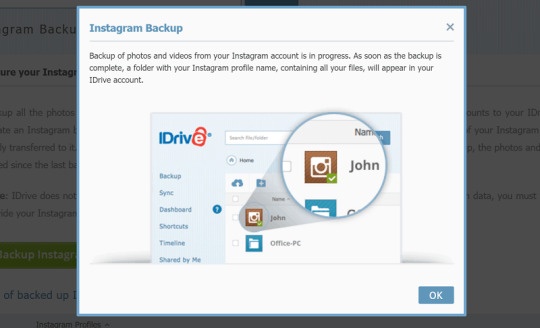
Backup is automatic and incremental, so only media added since your last backup gets copied. This saves time and bandwidth. You have to execute backups manually. This can be done from the IDrive web interface or from your Android or iOS device.
Affordable subscriptions are another reason to pick IDrive. You can get 2TB of backup for just over $50 a month or 5TB for just over $75. Either should be plenty of storage for your social media, desktop and smartphone content. There’s also a free 5GB plan.
For more information, including about features such as file sync and sharing, read our IDrive review.
Acronis True Image: Facebook, Instagram
While IDrive looks great on paper, it can be woefully slow. Rival Acronis True Image provides faster backups, thanks to a larger server network. It can also backup Facebook and Instagram, and does so more comprehensively than IDrive.
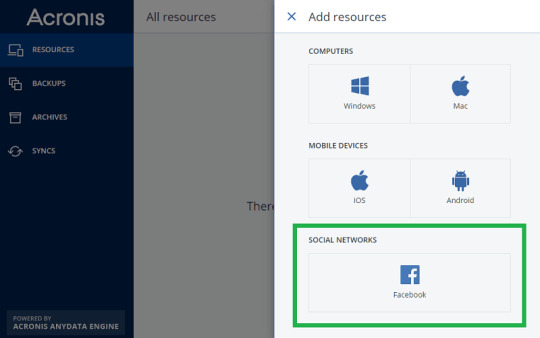
In addition to Facebook photos and videos, True Image preserves messages, contacts and likes. For Instagram, it saves all photos, a count of likes, tags and comments for each post.
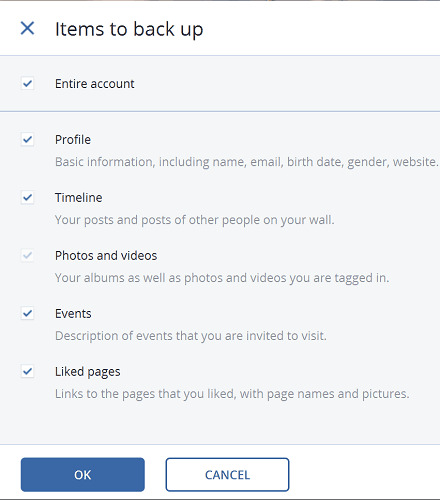
True Image backs up both platforms continuously. That means you don’t have to kick off your social media backup manually like you do with IDrive. Backups are incremental, so only data that hasn’t already been saved gets copied.
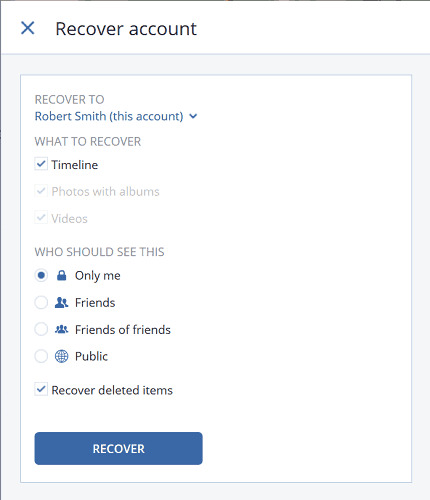
Should your Facebook or Instagram profile be deleted, Acronis True Image can even restore backed-up content to a new profile.
All data gets encrypted at rest in the Acronis Backup Cloud using 256-bit AES. For more privacy, an option for private, end-to-end encryption is available. As noted in our Acronis True Image review, you need to set that up before you start your backup.
You can backup Facebook or Instagram from the True Image web dashboard or your smartphone. Like IDrive, True Image ranks among the best online backup for mobile devices, with Android and iOS apps that can protect contacts, photos, videos and text messages.
The only reason not to consider True Image over IDrive for social media backup is that the cost is higher. It costs $50 a year for 250GB of backup, about the same price as 2TB of IDrive backup. There’s no free Acronis True Image plan, but you can try the service for 30 days before making a decision.
pCloud: Facebook, Instagram
pCloud is a cloud storage service that ranks as one of the best Dropbox alternatives available, providing similar features and better security, thanks to a zero-knowledge encryption add-on called pCloud Crypto. While file sync, file sharing and saving hard drive space are the big benefits of pCloud, it can also backup social media.
To setup backup, log in to the pCloud web interface and click the “backups” link. There are several services listed there for backup, not just Facebook and Instagram, but Google Drive, Dropbox and Microsoft OneDrive, too.
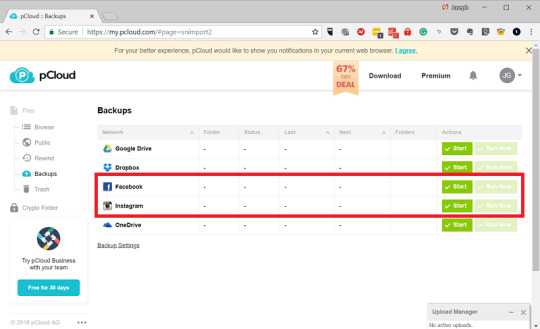
You’re only able to backup Facebook and Instagram albums, saving photos and videos. pCloud doesn’t look for tagged media, either.
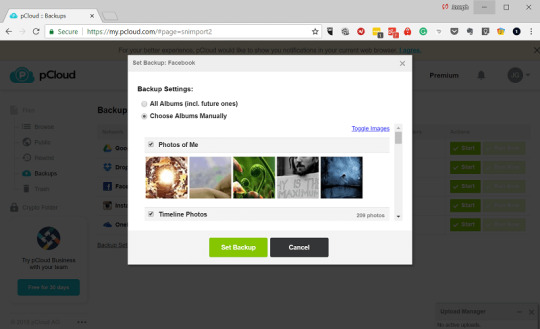
While limited in social media backup features, pCloud provides plenty of space for your images. You can sign up for a free 10GB account, a 500GB account for $5 a month or a 2TB account for $8 a month. We rank pCloud among the best free cloud storage services and believe its 2TB subscription to be one of the best deals in cloud storage.
Cloudsfer Social Media Backup
Cloudsfer isn’t an online backup or cloud storage service, but a middleman designed to transfer files between them. Cloudsfer lets you perform manual and scheduled file transfers. It doesn’t have as many cloud service options as other entries in our best cloud-to-cloud management list, but it does outperform them when it comes to social media.
Options include Facebook, Instagram, Flickr and 500px, a cloud storage tool for photographers that has social media features.
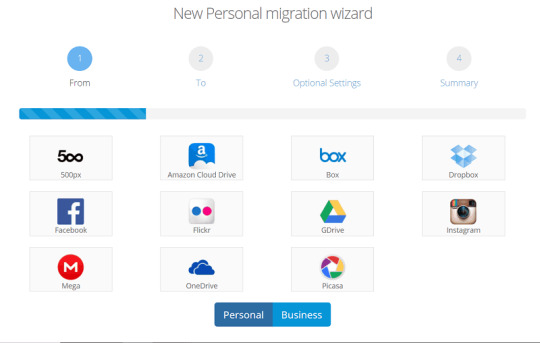
Unfortunately, Cloudsfer can only move images and photos and doesn’t have an option for tagged content.
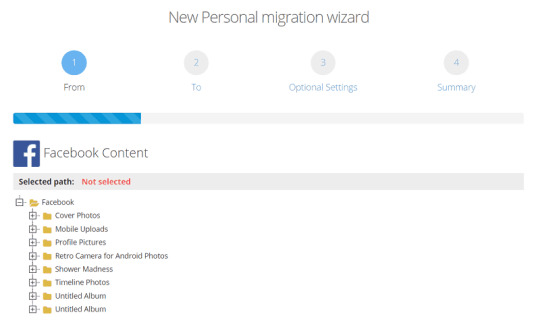
There is a free Cloudsfer plan. It doesn’t maintain file versions or provide filters, and you can only run one migration at a time, but that should be fine for social media backup.
With a Cloudsfer Personal plan, you can run three migrations at once, instead of just the one that the free plan permits. It’s too expensive for simple social media backup, though, at 75 cents a gigabyte, with a minimum charge of 8GB.
IFTTT Social Media Backup
While the tools mentioned so far work well for Facebook and Instagram, most other social media platforms are left out. Additionally, most online backup and cloud storage services don’t have native features to back up social media services. If your services of choice aren’t represented, one workaround is to use IFTTT for social media backup.

IFTTT provides a la carte integrations for web applications, many of which are cloud and social media services. The name stands for “if this, then that,��� describing its cause-and-effect approach to automation. In a nutshell, an action occurs on one service, such as a social media tag, and that results in a trigger action, such as storing the tagged item in Google Drive.
It sounds complicated, but it isn’t. IFTTT has several recipes available for social media backup ready to go, so all you have to do is sign up and pick your poison.
We can’t cover all the possibilities, but here are a few recipes we found for social media backup:
Twitter: add files in tweets to Dropbox
Twitter: save tweets to Google Docs
Tumblr: backup posts to Google Drive
Tumblr: backup posts to Evernote
Facebook: backup photos to Google Drive
Facebook: backup photos to Dropbox
Pinterest: backup pins to Google Drive
Instagram: backup photos to Google Drive
We have an article on backup with IFTTT, though it doesn’t focus on social media.
IFTTT rival Zapier has ready-to-roll social media backup algorithms, too. We suggest exploring IFTTT first, though, since it’s free and Zapier isn’t. If you’d like more help making a decision, here’s an article pitting IFTTT against Zapier.
Manual Social Media Backup
While automation and the cloud work best for backup, most popular social media platforms have manual options for downloading your data. These can be stored locally, or locally and remotely, if you want to follow the 3-2-1 rule of backup.
LinkedIn Backup
You can export a .csv file containing your connection data directly from LinkedIn. The file includes name, title, company and email address. It’s not perfect, but it’ll, at least, preserve your network information, so that you don’t lose those important contacts.
To export your network connections from LinkedIn:
Click “my network” at the top of your homepage
Click “your connections number” on the left
Click “manage synced and imported contacts” on the top right
Click “export contacts” under the “advanced” header
LinkedIn will prepare your file and email you within a few minutes. That email will contain a link letting you download a .zip file that includes your connections.
Facebook Backup
Facebook makes it simple to obtain a copy of your backup data. Click the little downward arrow near the top of your account, then click settings. Click “your Facebook information” on the left.
To the left of the words, “download your information,” click “view.” You’ll be redirected to a page where you can create a backup file with your posts, photos, videos, comments, likes, friends and almost everything else you’ve ever done on Facebook.
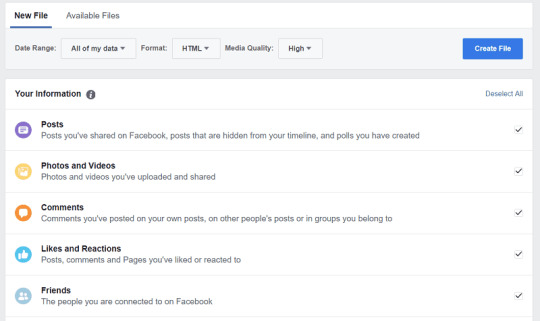
There’s even an option for ad topics that Facebook has deemed relevant to you and your location history, which makes Mark Zuckerberg seem like the world’s biggest creep.
Pick what information you want, a date range, format and media quality. Once you’re done, you can disable Facebook’s location services, if you want (settings > security & location > location).
Twitter Backup
Download your Twitter archive by heading to your account settings and selecting “settings and privacy.” On the next page, scroll down and select “your Twitter data” on the left-side menu.
Next, scroll down to the bottom of the page. There will be a button for “request Twitter data.”
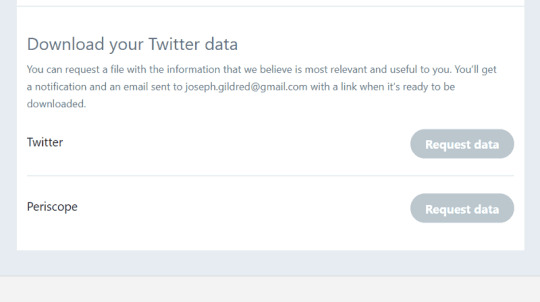
Click that and Twitter will prepare your file, sending you an email when it’s ready. You’ll then be able to download a .zip file with your Twitter archive.
Pro tip: if you’re using a backup service that automatically backs up by file type, that file will be automatically sent to the cloud. One such service is Backblaze. At $5 a month for unlimited backup, you won’t find a better deal. Read our Backblaze review for details.
Instagram Backup
As is the trend with social media, Instagram now provides a built-in feature to download your data for backup. This feature isn’t restricted to photos and videos. You can download a record of your archived stories, profile, contacts, likes, direct messages, searches and several other things.
To download your data, go to your profile page and select the “privacy & security” link. Scroll down and click “request download” under the “data download” header.
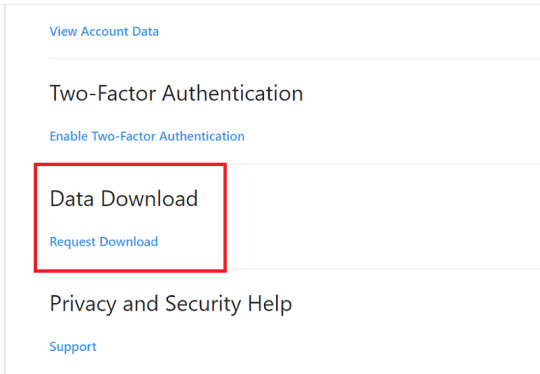
Input your email address and Instagram will let you know when your download file is ready, which can take up to 48 hours.
Final Thoughts
The key to backing up is thinking ahead. Though it seems reasonable to assume that your social media content will always be there, photos get deleted, friends unfriend and accidents happen, even in corporate data centers.
Sign up for our newsletter to get the latest on new releases and more.
The best bet for keeping your Facebook and Instagram data preserved is using Acronis True Image, which continuously and incrementally backs up data. For a cheaper approach, both IDrive and pCloud work well, as does using IFTTT for social media and storage services that aren’t supported.
Share your thoughts on social media backup below and let us know what strategies you use. Thanks for reading.
<a style="display:none" rel="follow" href="http://megatheme.ir/" title="قالب وردپرس">قالب وردپرس</a>
The post How to Backup Social Media in 2018 appeared first on MusicCosmoS.
0 notes
Text
How to Migrate Google Drive Content?
Google has gone a long way from simply being a research project of Larry Page and Sergey Brin at Stanford University in 1996 to becoming the largest search engine in the world. Google has already established itself as the primary search engine and has grown into a very huge business enterprise. Pundits likewise predicted before that Google would someday create its own file storage service, and at present, it has become a reality. Google now offers various services, and one of these services is Google Drive.
Google Drive is not only a file storage platform, but is also a synchronization service rivaling those of SharePoint of Microsoft and Notes of IBM. The Google Drive allows its end-users to store their files and data in the cloud. Google Drive likewise offers various apps with accompanying offline capabilities for both macOS and Windows. It also consists of Google Docs, office suite, and Sheets and Slides that allow collaborative works like editing of documents, presentations, spreadsheets, forms, drawings, and many more. At present, more and more users are shifting to the use of Google Drive because Google Drive provides free storage.
There are instances however when you would like to migrate your files from Google Drive to another platform and this migration would definitely require you to follow certain patented steps on data migration. Here are the simple steps on how to migrate Google Drive contents to another platform:
· First, you need to create a complete Document Migration Project.
· Afterwards, you can make use of advanced options in order to customize the project.
· You should then add the items that you would like to migrate to the customized project.
· You should also run an assessment to find the licenses that you need in the migration process.
· Afterwards, you need to buy those licenses.
· Once you got all the needed licenses, you can begin migrating your files.
The google drive migration, based on the abovementioned steps appears easy and simple. Yet, it is not, and more often, if you are not cognizant of the intricacies of the protocols and other factors in data migration, you may end up losing your files or corrupting some of your files. The seemingly simple google drive transfer above is, in actuality, a difficult task for the uninitiated into the process of data migration. Hence, it is sometimes good to admit that if you are not an expert in the process of data migration, it would be better for you to avail of the service of a third-party service provider that thrives in data migration.
There are many third-party solutions providers that offer data or file migration, and one popular leading web service for quick, secure, and streamlined content migration is Cloudsfer. Cloudsfer is powered by Tzunami. With the help of Cloudsfer service, you will no longer need to master the many and intricate steps involved in file transfer. Cloudsfer can readily handle the task for you, hassle-free, allowing you to focus your time and effort on some more pressing issues within your business. Lastly, Cloudsfer can centralize the migration process for you, while preserving all the sharing settings and metadata of your documents and files.
1 note
·
View note
Text
Backup Dropbox and Content Migration
Huge corporations always have sensitive information and data to take care of. They often put these data and information in their huge storage systems to secure these data and information from any breach and for further reference in the near future. Data and information accumulate inside these storage system, and for this reason, a company, for example, sometimes need to migrate the content of these storage to a better and more secure storage system. Similarly, even the ordinary guys who are using the Facebook or any other social media platforms, for example, usually store their valuable photos and other information on these social media platforms. There are instances, however, that they have to migrate their Facebook pictures to other cloud storage systems like DropBox. Backup facebook photos to DropBox can be a bit difficult if you are not cognizant of the important steps on how to migrate content. You can facilitate a cloudfile transfer by simply availing of Cloudsfer service.
What Does Cloudsfer offer to its Clients?
Cloudsfer, as a content migration service, has been in this kind of business for almost 16 years. It generally offers content migration service for both big and small projects, and it thrives in providing optimized solutions for clients who would like to have a smooth migration of content. It likewise offers complete scalability prior to the process of content migration, and provide a singular UI for multiple systems. With Cloudsfer, you can migrate your content among 20 cloud systems without a snag. Moreover, the migration system provided by Cloudsfer does not require additional resources and it is fully secured. Cloudsfer system likewise maintains permissions between various systems and maintain the sharing settings within the target system. Furthermore, it also maintains the original metadata of files. The Cloudsfer system also applies file filters by size, date, and file type. Lastly, you can also get a free hand in the scheduling of the content migration process.
The Primary Reasons behind Content Migration
There are many reasons why companies or organizations migrate their content from one storage to another storage system. They usually engage in content migration to solve some nagging issues relative to their content storage. First, they engage in content migration to consolidate one or more CMS systems. This consolidation definitely leads to more centralized control of content and better management of the content. Second, they need to migrate their content because they are now merging with another entity or they have acquired another organizational entity just like in the case of a merger of businesses. Third, they need content migration to standardize the formatting of their contents. Lastly, they need more security for their content and for this reason, they need a better and more secured storage platform.
Content migration may be fraught with intrinsic problems and risks that may be burdensome to the one who is migrating his content. There is the risk, for example, of corruption of files during migration. There is likewise the need for additional resources, and for this reason, content migration can be a resource intensive undertaking. Lastly, the auditing process of content migration can be tricky and complex, and for this reason, there is a need for traceability and continuity in the process.
0 notes
Text
Cloud File Transfer and Content Migration
Any huge organization or business enterprise definitely protects its private data and information and necessitates a storage system that would provide space for the protection of those data and information. These data and information are usually stored on the CMS or content management system, DAM or digital asset management, and DML or document management system. Other information could likewise be stored on Flat HTML based system, Active Server Pages, and many other storage systems. These systems ensure that the file and information would be readily protected and could be easily accessed for immediate viewing and use.
The passing of time and the introduction of various storage technologies and protocols often render the previous storage systems and files obsolete. Hence, more often, a company or an organization needs to migrate its content to solve the following issues at present. There are other issues that necessitate the need for content migration, and some of these issues include the act of consolidating the storage systems into fewer and manageable systems. With the consolidation process, management can have perfect control of their files and can create a centralized control of the storage of the data and information. Moreover, content migration allows for better file sharing.
There are instances likewise wherein there is a need for file migration because the company is reorganizing or is undergoing assimilation or merging of companies. Content migration is likewise necessary in cases of files that have grown organically obsolete or need standardization of the formats so that all contents will have a unified branding. Moreover, content migration is necessary for the simplification of the versions of files and adaptation to new platforms. Lastly, it is necessary for auditing content access, and improving the security management of contents.
There are however those people who argue against migrating content. They maintain that there are dangers concomitant with moving huge data because such migration would expose the data to certain risks such as corruption during transit, loss of context, and risk of losing the continuity of data which will eventually produce broken links.
Content Migration via Cloudsfer
If you have files, for example, in Facebook and OneDrive that you would like to migrate for further protection and other reasons, you can avail of any web service that provides content migration service. One such web service provider is Cloudsfer—a service that specializes in smooth and secure content migration. Backup facebook content is as cool and smooth via the help of Cloudsfer. Backup onedrive likewise is as simple as transferring a book to another bookshelf. Cloudsfer can handle the content migration and can help you avoid dealing with many risks associated with content migration process. It offers the capability to migrate among more than twenty cloud systems while providing a single user interface. Moreover, during the process of content migration with Cloudsfer, there is no need for any installation or additional resources. The system that Cloudsfer provides is also highly scalable.
Other features provided by Cloudsfer include security migration, maintenance of metadata, file filtering, scheduling of migration, complete migration report, delta migration, expert settings, and multi-user migration. Cloudsfer likewise supports around 40 cloud storage providers.
Content migration can be a risky undertaking for those who are uninitiated into the process. Hence, to avoid the risks concomitant with content migration, you can simply avail of the service of web service providers like Cloudsfer to facilitate content migration for you.
0 notes